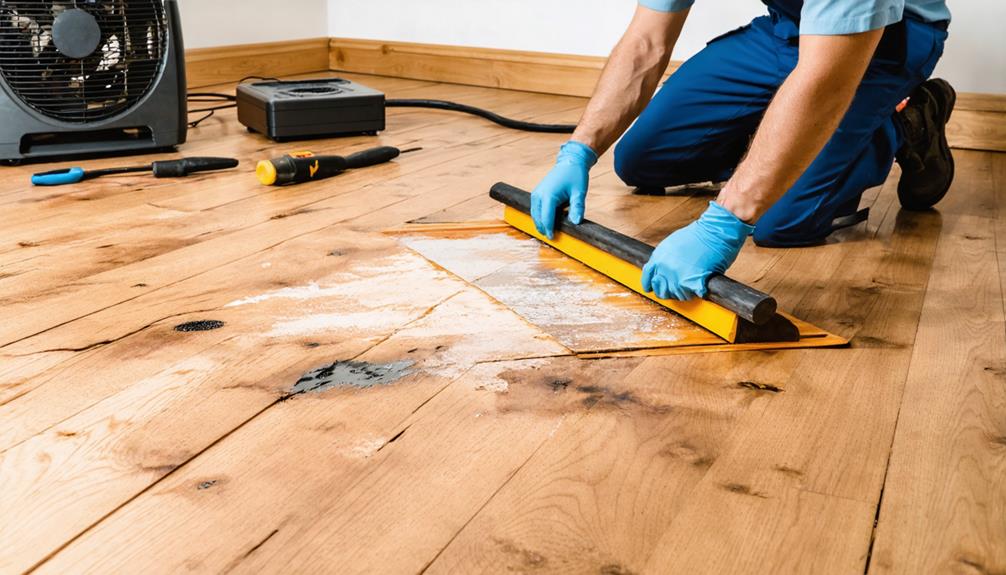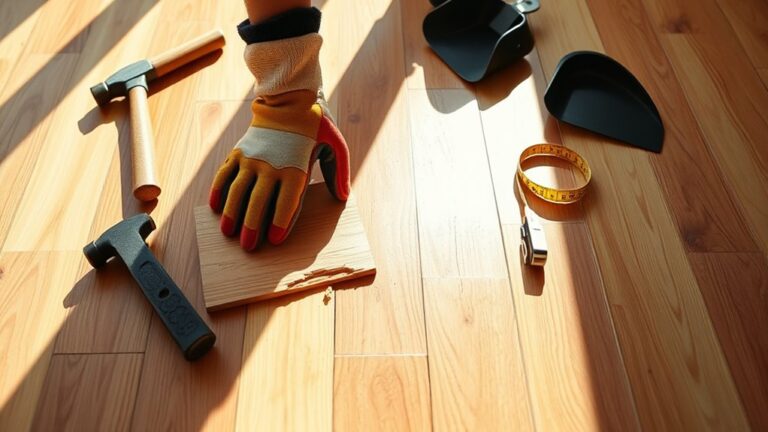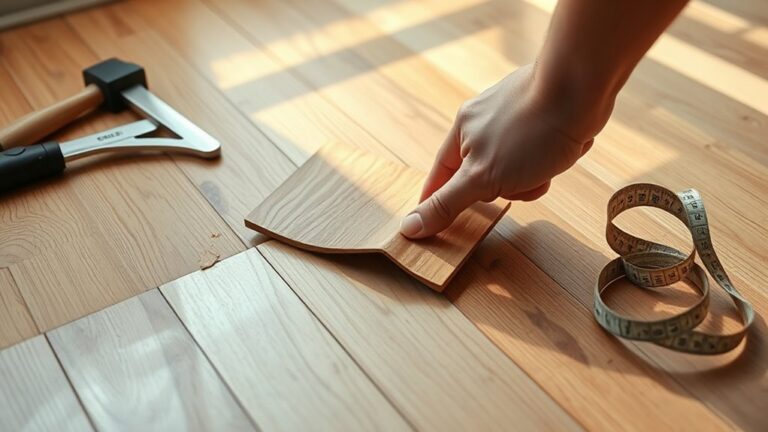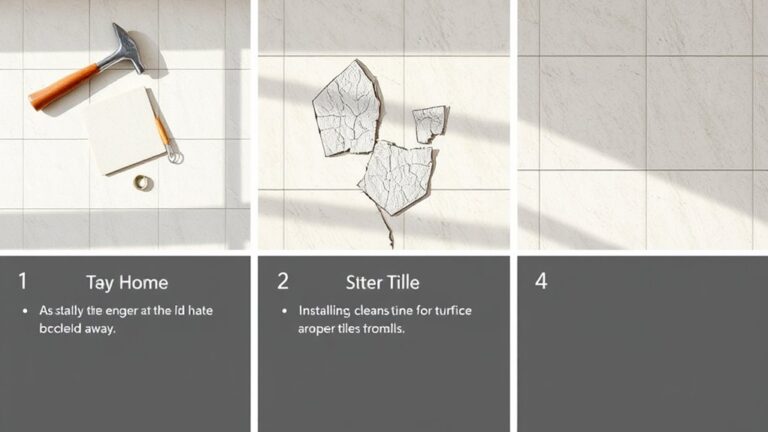Fixing moisture damage in floors starts with identifying the problem. Look for signs like buckling in hardwood, swelling in laminate, or curling edges in vinyl. Remove any obstructions, ensuring the area is clean and dry. Use a shop vacuum for standing water, then clean with detergent and disinfectant. Increase airflow with fans and dehumidifiers for thorough drying. If sections are severely damaged, you might need to replace them. Always verify moisture levels are safe before repairing to prevent future issues. There's more to contemplate regarding prevention and when to call professionals, so keep exploring your options.
Identifying Moisture Damage
When it comes to identifying moisture damage in your floors, you'll want to keep an eye out for several key signs. If you've got hardwood floors, look for cupping, buckling, or discoloration. These indicators often mean your wood is experiencing severe water exposure, leading to potential long-term issues. Water damaged wood floors can be tricky; if you notice these changes, it's crucial to act fast.
In addition to hardwood, other flooring types can show signs of moisture damage too. Laminate floors might swell or warp, and if you spot these issues, you'll likely need to replace the affected boards immediately to avoid further deterioration. Vinyl floors can also fall victim to moisture, displaying buckling or soft spots that require thorough inspection and potential repair.
Don't forget about visible mold or dark spots. These are serious red flags that indicate prolonged moisture presence. If you see these signs, you should consider calling in a professional for assessment and remediation. Finally, trust your nose; if you detect odors of mildew or a musty smell, it's time to investigate your flooring condition and the underlying moisture issues.
Signs by Floor Type
When it comes to moisture damage, different floor types exhibit unique signs that you should watch for. For hardwood, cupping and discoloration are clear indicators, while laminate and vinyl floors may show warping or buckling. Recognizing these signs early can save you from more extensive damage and costly repairs down the line.
Hardwood Floor Indicators
Identifying moisture damage in hardwood floors is vital for maintaining their integrity and appearance. One of the first signs to look for is cupping, where the edges of the boards curl upwards while the center dips downwards. This usually indicates excessive moisture content in the wood. Conversely, if you notice crowning—where the center of the board is higher than the edges—this suggests moisture issues from above.
Discoloration and dark spots on your hardwood flooring can signal mold or mildew growth, pointing to significant water damage. If you see these changes, it's imperative to inspect the area thoroughly. Another major concern is buckling, where boards lift away from the subfloor; this typically indicates severe moisture exposure that demands immediate attention.
Lastly, don't ignore any musty odors emanating from your floors. This often means moisture is trapped beneath the surface, which could lead to further complications if left unchecked. Regularly monitoring these indicators can help you protect your beautiful hardwood floors and maintain their lasting appeal.
Laminate and Vinyl Signs
Moisture damage can manifest in laminate and vinyl flooring in several noticeable ways, making it vital for homeowners to stay vigilant. In laminate floors, keep an eye out for signs like warping, swelling, and dark spots that may indicate mold growth. If you notice any of these issues, it's important to act fast. Prolonged moisture exposure can lead to delamination, where the layers begin to lift or separate.
For vinyl floors, signs of damage include buckling or curling edges, which signal that moisture has infiltrated the material. You might also feel a spongy sensation underfoot, a clear indicator that water has seeped beneath the surface.
When you encounter water leaks or spills, don't delay in addressing them. Both laminate and vinyl flooring types require immediate action to prevent extensive damage and possible replacements. Regularly inspecting these signs not only helps you maintain the integrity of your floors but also allows you to enjoy the freedom of a clean, safe, and beautiful home environment. Stay proactive, and your laminate and vinyl floors will thank you!
Preparing for Repairs
Before you start repairs, assess the extent of the damage to understand what needs fixing. Next, remove any standing water using a shop vacuum, and make certain the area is as dry as possible. Finally, guarantee proper drying by improving ventilation and cleaning the floors thoroughly to prevent mold growth.
Assess Damage Extent
Evaluating the extent of damage in your floors is essential for effective repairs. Start by removing any furniture and personal items from the affected area. This will allow you to fully assess the damage extent without obstructions. Look for visible signs like warping, buckling, or discoloration, as these indicate the severity of moisture intrusion.
Next, grab a moisture meter to accurately measure moisture levels in the flooring and water-damaged sub-floor. This tool will help you determine if further drying or repairs are necessary. Pay attention to any areas where excess moisture could still be lurking, as this can complicate the repair process.
Also, don't forget to check for mold presence, which can signal prolonged moisture exposure. If you find mold, it's wise to contemplate professional assessment and possible remediation.
Remove Surface Water
Once you've assessed the damage, it's time to tackle the surface water that may still linger. Removing surface water is vital to prevent further moisture issues and potential mold growth. Start by using a shop vacuum designed for water extraction to eliminate any standing water quickly.
To guarantee you're thorough, consider these steps:
- Use a sponge or squeegee alongside the vacuum to collect moisture from corners and crevices.
- Clean the floor with a mixture of detergent and mild disinfectant to remove dirt and organic material that could encourage mold.
- If you suspect mold presence, treat the affected areas with trisodium phosphate to kill mold spores and prevent further contamination.
- Open doors and windows to enhance ventilation, as good airflow is important for reducing moisture levels.
Ensure Proper Drying
As you prepare for repairs, ensuring proper drying is imperative, especially if moisture has seeped into your flooring materials. Start by removing all standing water immediately. Use a shop vacuum, mops, or towels to eliminate excess water and prevent further moisture penetration into the flooring.
Next, increase airflow in the affected area. Open windows and doors, or utilize fans and air movers to expedite the drying process and reduce humidity levels. This step is critical because stagnant air can prolong moisture retention, leading to further damage.
Employ dehumidifiers to extract excess moisture from the air. Maintaining low humidity is essential for effective drying and preventing mold growth. Keep an eye on moisture levels using a moisture meter. This will allow you to confirm that the flooring and subfloor have reached acceptable dryness before you proceed with any repairs.
Bear in mind that drying may take several days, particularly for wood floors, if moisture has penetrated deeply. Patience is key; rushing the process can lead to inadequate drying and lasting damage. Taking these steps will prepare your flooring for a successful repair.
Repairing Water-Damaged Floors
When dealing with water-damaged floors, it is vital to act quickly to minimize further deterioration. Start by identifying the extent of the water damage. Look for signs like cupping, buckling, or dark spots on your hardwood floors, as these indicate varying levels of moisture intrusion.
To fix water issues effectively, follow these steps:
- Remove as much standing water as possible using a wet/dry vacuum.
- Clean the affected area with a detergent and mild disinfectant to prevent mold growth.
- If the damage is extensive, replace affected sections of flooring, such as individual hardwood planks or damaged laminate boards.
- Make sure all areas are thoroughly dried out, utilizing dehumidifiers and fans to expedite the process, particularly in humid conditions.
Once you've addressed the immediate water damage, it is important to verify that the flooring is completely dry before proceeding with repairs. This helps prevent further deterioration and guarantees a successful repair. If the damage is severe, don't hesitate to consult professionals. They can provide expertise in moisture content testing and recommend appropriate repair or replacement solutions tailored to your specific situation.
Taking these steps will not only help you reclaim your space but also make certain that your floors maintain their integrity for years to come. Remember, swift action is key to fixing water-damaged floors effectively!
Assessing Subfloor Conditions
Evaluating the conditions of your subfloor is vital for guaranteeing the long-term health of your flooring. Start by inspecting the subfloor for any signs of structural damage. Look for loose or uneven surfaces, which could indicate deeper issues that need to be addressed. It's important to assess the integrity of the materials beneath your flooring, especially if it's wood, as moisture can lead to considerable damage over time.
Next, use professional equipment to test the moisture content in your subfloor. Prolonged exposure to moisture can lead to mold growth and compromise the structural integrity of the wood. Be vigilant, as even concrete subfloors can experience moisture issues that require prompt attention to avoid long-term problems.
Airflow accessibility is another key factor in your assessment. Confirm that areas like crawlspaces have adequate ventilation to facilitate proper drying. This will greatly affect the moisture removal process, helping prevent further damage.
If you find that your wooden subfloor is excessively damp, you might need to remove the flooring above to allow for complete drying. Ignoring this step could result in mold proliferation and further damage.
Cleaning and Drying Techniques
Once you've assessed the subfloor conditions and identified any moisture issues, the next step is to implement effective cleaning and drying techniques. Start by removing any surface water from the affected area. You can use a shop vacuum or a sponge and squeegee to prevent further moisture absorption into the flooring.
After that, it's essential to clean the area thoroughly. Use a mixture of detergent and a mild disinfectant to scrub away dirt and organic material, as this will help prevent mold growth. If you spot any mold, treat it with trisodium phosphate, carefully following the manufacturer's instructions for safe application and removal.
Next, focus on the drying process. Open doors and windows to enhance airflow, which aids in natural drying. To expedite this, consider using fans and dehumidifiers to pull moisture from the air.
Here's a quick checklist to guide you:
- Remove surface water using a shop vacuum or sponge.
- Clean the affected area with detergent and disinfectant.
- Treat any mold with trisodium phosphate.
- Use fans and dehumidifiers to accelerate the drying process.
Prevention Strategies
To effectively prevent moisture damage in your floors, it's vital to adopt proactive strategies that minimize water exposure. Start by installing rugs and mats at entry points. These simple additions can absorb moisture from shoes, greatly reducing the risk of water exposure to your floors.
Next, make it a habit to regularly inspect your plumbing systems and roofing for water leaks. Catching these issues early can prevent water intrusion that could lead to serious moisture problems. If you spot any leaks, address them promptly to safeguard your flooring.
For hardwood floors, sealing them every few years can enhance their resistance to moisture and prolong their lifespan. This protective layer helps to keep moisture from seeping into the wood, which can cause warping or other damage.
Additionally, be vigilant about cleaning up spills and standing water immediately. The longer moisture sits on your flooring, the higher the risk for saturation and damage. Consider using water vacuums for quick removal of any standing water, as they can effectively minimize the risk of moisture-related issues.
When to Seek Professionals
When it comes to moisture damage, knowing when to seek professional help can make all the difference in preventing further issues. If you notice signs of extensive water damage, it's vital to act fast. Here are some key situations where you'll definitely want to call in the experts:
- Significant buckling or warping: If your floors are visibly warped, it's often a sign that the damage is severe, and you may need to replace sections of your flooring.
- Mold growth: When mold starts to appear, it's not only a health concern but indicates persistent moisture issues that require a professional assessment.
- Contaminated water: If the source of the water includes sewage or floodwater, professional cleanup is essential to guarantee your safety and proper remediation.
- Persistent moisture readings: If your moisture readings exceed recommended levels—generally above 15% for wood—after initial drying efforts, don't hesitate to get a professional to evaluate the situation.
Cost Considerations for Repairs
Addressing moisture damage not only involves recognizing when to call in professionals but also understanding the financial implications of repairs. When it comes to cost considerations, you'll find that repair expenses can vary greatly based on the extent of the damage. Small affected areas typically cost less to fix, while larger sections or entire floors needing replacement can really add up.
Labor costs often range from $50 to $150 per hour, depending on the complexity of the job and the local market rates. Material costs for replacing damaged flooring—like hardwood, laminate, or vinyl—can vary widely too, averaging between $3 and $10 per square foot, not including labor.
It's essential to act swiftly. Timely responses to moisture issues can greatly reduce overall repair expenses. Prolonged moisture exposure can lead to more extensive damage, requiring thorough repairs or even full replacements, which are much more costly.
Also, check your insurance coverage. Many policies include provisions for water damage repairs, potentially helping you offset some of these costs. However, the specifics depend on your policy's terms and conditions regarding claims for water damage.
Frequently Asked Questions
How Do You Fix Moisture in the Floor?
To fix moisture in the floor, you'll want to start with moisture detection to identify the affected areas. Use appropriate drying techniques, like fans and dehumidifiers, to help eliminate excess moisture. Assess your flooring materials for any signs of damage, and consider restoration methods for minor issues. For long-term success, implement prevention strategies, such as regular inspections and ensuring proper ventilation, to keep your floors dry and in good condition.
Do You Have to Replace the Subfloor if It Gets Wet?
Think of your subfloor like a sponge—sometimes it can absorb moisture without falling apart, but too much saturation can lead to a messy situation. You don't always have to replace it; it depends on moisture detection results. If you notice signs like sagging or mold, then repair techniques might not be enough. Always consider preventive measures to avoid future issues and keep your flooring materials in top shape for the long haul.
Can Water Damaged Wood Floors Be Saved?
Yes, water-damaged wood floors can often be saved if you act quickly. Restoration techniques like drying and dehumidification can help restore flooring materials showing minor damage. It's essential to follow prevention tips, such as ensuring proper drainage and humidity control. Regular maintenance practices, like cleaning spills promptly, can also protect your floors. If damage is significant, consider consulting professionals to assess the situation and implement effective recovery strategies.
How Do You Fix Moisture in a Subfloor?
"An ounce of prevention's worth a pound of cure." To fix moisture in a subfloor, start with moisture detection to identify the source. Implement drainage solutions to prevent future issues. Remove affected flooring materials and inspect the subfloor for damage. Use dehumidifiers and fans for drying, focusing on mold prevention. If rot is present, proceed with subfloor repair by replacing damaged sections, ensuring everything's dry before reinstalling the flooring.




